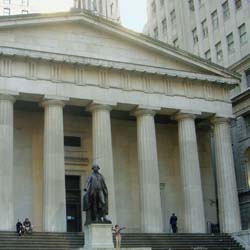
|
TUCKAHOE
MARBLE
|
 |
|
| Official Name: | Inwood Formation | |
| Location: | Westchester County, NY | |
| Age: | Late Cambrian - Early Ordovician | |
| Lithology: | Marble | |
| NYC Examples: | Federal Hall, Brooklyn Borough Hall, Washington Memorial Arch, Grace Church | |
|
|
The Tuckahoe Marble lies within the Inwood Marble Formations which crops out across northern Manhattan, the Bronx, Westchester County, and western Connecticut. Headstones carved
from Inwood Marble from northern Manhattan (Marble Hill) and the Bronx
(Kings Bridge) are found in Lower Manhattan's 17th-century Shearith Israel
Cemetary, and 18th-century Trinity churchyard where the oldest Inwood
Marble headstone with a legible inscription dates to 1723. |
|
Shearith Israel Cemetary
(1682-1828) |
| In 1822, deposits of high-quality white marble were discovered along the Bronx River between Tuckahoe and Eastwood in Westchester County. Tuckahoe Marble was used to construct grand early nineteenth-century NYC Greek Revival buildings such as Federal Hall (1830), and Brooklyn Borough Hall (1840), the Italianate Stewart's "Marble Palace" (1846)--New York's first department store--and the Washington Memorial Arch in Washington Square. Tuckahoe Marble was the single most important white marble deposit in America until the latter part of the 1800's, at which time reliable access to the extensive high-quality marble deposits of southwestern Vermont was established. Quarrying of Tuckahoe Marble ceased in 1930. | ||
 |
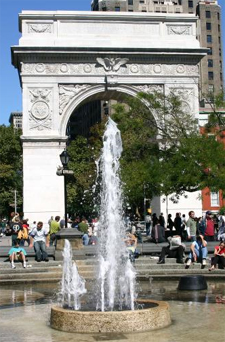 |
|
|
Brooklyn Borough
Hall (1840)
|
Washington
Memorial Arch (1895)
|
|
|
GEOLOGICAL FEATURES OF THE TUCKAHOE MARBLE The Tuckahoe Marble is composed predominantly of medium to coarse-grained calcite (CaCO3) and dolomite (CaMg[CO3]2). This white marble also contains common porpyroblasts of tremolite (CaMg5Si8O12[OH]2). The crystals of this light-colored amphibole protrude from weathered surfaces as long crystals with rhombic cross-sections (see below). Diopside (CaMgSi2O6) occurs are irreglar pale green crystals. The mica phlogopite (K2Mg6Al2Si6O20[OH]4) is also common, and occurs as small tawny crystals, and irregular bands and blobs. Silicate-poor layers are metamorphosed dolomitic limestones, whereas the silicate-rich layers are the metamorphic equivalent of dirty dolomitic limestones (a mixture of clays, silt, and carbonate minerals). The Tuckahoe Marble contains minor amounts of hematite and pyrite. Oxidation of these iron-bearing minerals cause the stone to turn orange-brown when the rock is exposured and weathers. |
|
|
|
|
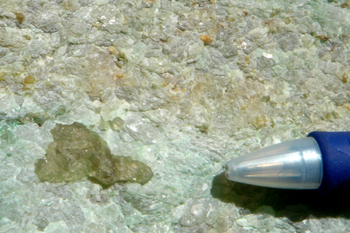 Diopside Porphyroblast in Tuckahoe Marble Federal Hall, Wall Street |
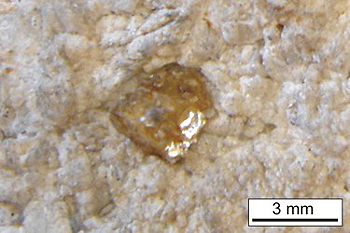 Phlogopite in Tuckahoe Marble Grace Church, East Village |
| ENVIRONMENT OF FORMATION | |
|
The history of the Tuckahoe Marble begins 500 million years ago in the Late Cambrian to Early Ordovician. At this time an ocean incursion swept over much of Laurentia (the ancient continent that forms the heart of modern North America) creating broad, marine platforms. Calcitic sediments accumuated in In this shallow, tropical environment, to form a a thick limestone sequence. In the Middle to Late Ordovician
a volcanic island arc terrane collided with the southern margin of Laurentia.
In the compressional event of the Taconic Orogeny, slices of Inwood platformal
carbonate rocks were buried by more than 40 kilometers of rock, and the
dolomitic limestones metamorphosed to form the Inwood Marble under very
high pressure-temperature conditions (granulite facies). During
the Devonian, a suite of small granite bodies intruded the New York City
region. These granites reintroduced water to the dry diopsidic marbles,
and caused new hydrous minerals to form. The tremolite in the Inwood Marble
formed during this retograde amphibolite-facies metamorphic event. |
|
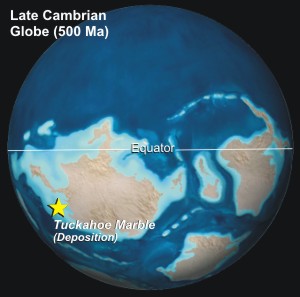 |
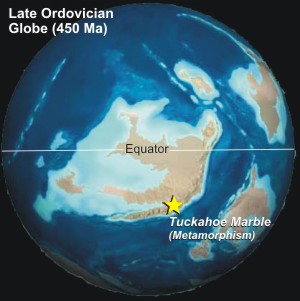 |
|
Images
adapted from: |
|
© 2005 Wayne G. Powell